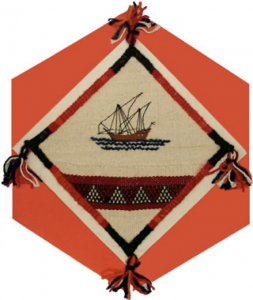Kuwait

The Block
Made from a camel bag donated by His Excellency Majdi Al-Dhafiri of the Embassy of the State of Kuwait, this block showcases the ancient art of Bedouin weaving. The pattern is woven with wool that has been hand-dyed using traditional natural dyes. Called al sadu in Arabic, this art-form records a passing way of life. The designs portray the stark beauty of the desert and reflects the country’s rich heritage. The embroidered wooden ship (dhow), with its distinctive sails, represents Kuwait’s long history of maritime life and the dangerous tradition of pearl diving. Tightly packed blanket stitches in hand-dyed red, black and orange yarn create a solid border around the scene. Typically, camel, sheep and goat wool is used for weaving. Tassels, attached at each corner, reflect an important decorative element in Kuwaiti cultural traditions.
Cultural Profile
Kuwait, which means ‘little fort’ in the local dialect, is a small country in the Middle East. This nation has a high standard of living and impressive, innovative architecture. The country, though mostly made up of desert, has a coastline on the Persian Gulf, as well as 9 islands. As a result, many aspects of Kuwaiti culture are related to the sea. A significant part of the population, known as Bedouins, once lived a nomadic life until the discovery of oil encouraged them to become more settled. The official language is Arabic, although English is widely understood and spoken.
In Kuwaiti society the family has always been important and while traditionally, a large number of children was associated with prestige and honour, today’s average family size is much smaller. Kuwaitis use food to convey their spirit of hospitality and generosity. The Deewania, or parlour, is an essential part of Kuwaitis’ social life. The Deewania, once meaning the front room of a house to receive guests in, now designates the gathering itself that takes place during which matters are discussed and coffee, tea and sweets are shared. Central to the hospitality is Arabic coffee, served from the ever-present, ornate coffee pots.
Known for its jewelry, hand-woven textiles, energetic sword-dancing and falconry, Kuwait is working to revive interest in its traditional handicrafts, lost as a result of modernization.
Many Kuwaitis now living in Canada have come here for medical education while still maintaining strong ties with their homeland. Their numbers remain small, and in 2011, there were just over 2,000 Kuwaitis living in Canada.
Sponsor: Embassy of the State of Kuwait
